There is an old saying among politicians that “all politics are local.” The same could be said for PSA campaigns, because the media which use PSAs do not care about national issues nearly as much as what is impacting their community. And, while the national office or its ad agency may create your campaign, they obviously don’t know the local community like those who live and work there. With these things in mind, this guide is designed to help local community outreach representatives get increased PSA exposure.
Definition
Before going into outreach techniques, it is important to understand what constitutes a PSA and the environment in which they are used.
Public Service Advertising – also known as Public Service Announcements (broadcast) and Public Service Ads (print) – are provided by the media at no cost to non-profit organizations and government agencies which qualify for PSA airtime and space. However, it is very important to understand that the media is not mandated to air or print PSAs. It is strictly a voluntary act on their part.
While it is true that broadcasters must prove they are broadcasting in the public interest, they can do that in many ways beyond airing PSAs. Accordingly, you must find ways to elicit local PSA usage and make a strong connection between your cause and the local media that will support it.
For more details on what is and what is not acceptable to media gatekeepers, read the article at https://www.psaresearch.com/network-clearance/ entitled: “Network Clearance – A Producer’s Checklist.”
Why Localism Matters
 Due to tremendous competition for PSA time and space, your success in PSA placement depends on how well you market your issue locally.
Due to tremendous competition for PSA time and space, your success in PSA placement depends on how well you market your issue locally.
All things being equal – creative quality of your materials, relevance of your issue and having appropriate materials – the organizations which do
the best local marketing job will be most successful in getting exposure.
As shown here, local issues trump all other factors in terms of importance to local media. In a survey of 1,000 broadcast TV stations, nearly two-thirds of the respondents indicated that “Benefits Community” was the most important factor to local TV stations.
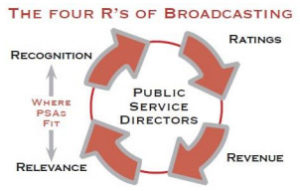 It is also important for you to understand the media mindset – particularly for broadcast TV, which will deliver the largest audience and value for your campaign. What really matters to local broadcasters is audience size (Ratings) because that is what their advertising revenues are based upon. Shown in this graphic is what we call the “Four R’s of Broadcasting.”
It is also important for you to understand the media mindset – particularly for broadcast TV, which will deliver the largest audience and value for your campaign. What really matters to local broadcasters is audience size (Ratings) because that is what their advertising revenues are based upon. Shown in this graphic is what we call the “Four R’s of Broadcasting.”
In order to build a bigger audience and the revenue that comes with it, the media need to provide relevant programming and generate recognition in your local market. This is where PSAs come into the picture, because they help the media demonstrate support for important local issues and get recognized for that support.
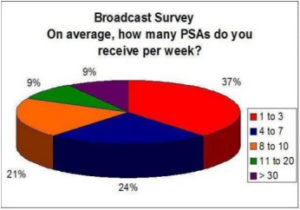 Knowing the media is on your side is the good news. The bad news is that there is a tremendous amount of competition for PSA support, and the demand far exceeds the supply. As shown here, two thirds of all TV stations receive from 4 to more than 30 PSAs per week.
Knowing the media is on your side is the good news. The bad news is that there is a tremendous amount of competition for PSA support, and the demand far exceeds the supply. As shown here, two thirds of all TV stations receive from 4 to more than 30 PSAs per week.
PSA Distribution in the Digital Age
As of July 2016, we began distributing digital files to the media instead of hard copy tapes and DVDs. This resulted in a significant difference in how stations receive PSAs, how local public affairs networks can access them, and in their outreach efforts.
There are two different ways that we distribute broadcast PSAs in a digital world: the “pull” and “push” methods. The pull method is to try and get the media to download our client files from our digital download site called “PSA Digital,” which you can access at:
https://www.goodwillcommunications.com/capabilitiesservices/psa-digital/
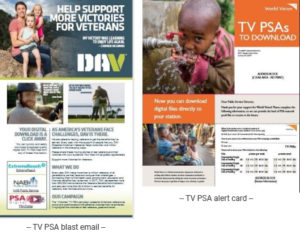 Typically we do that by sending a blast email and direct mail postcard to the media letting them know the URL for the download site such as those shown here.
Typically we do that by sending a blast email and direct mail postcard to the media letting them know the URL for the download site such as those shown here.
The push method uses a digital distribution service to feed the digital files to a dedicated server at the TV or radio station. Since the digital files go to the Traffic Director, rather than the public service director, we send Traffic Instructions along with the digital files, a combination storyboard and newsletter in .PDF format, and an evaluation reply card to capture any usage that may be missed by Nielsen. The article at the following link provides more details. https://www.goodwillcommunications.com/wp-content/uploads/2016/12/DigitalDistribution.pdf.
Outreach Tactics
Now that you understand what is important to the media, you are ready to sell them on your issue. The first step is to develop a good media contact list.
If you are working with a PSA distributor, they will handle all aspects of distribution. If you need to develop them, there are various resources such as which you can use to develop your own lists.
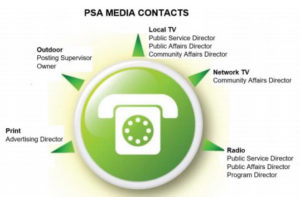 “Making the Contact
“Making the Contact
There is no single individual or department that controls PSA access for different types of media. The decision making process differs by media type, from one market to another, and by the size of the media outlet. Generally the people you want to contact are shown in this graphic.
Once you have compiled your list of local media, the next step is to “soften the market” by providing the media with some background information on your campaign. You can do this by sending them custom newsletters, blast emails, direct mail or perhaps your storyboard with a letter telling them why your campaign deserves their attention.
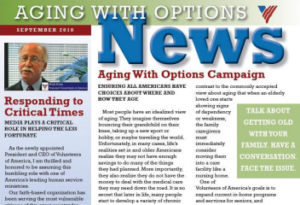 The next step is to make follow-up calls to pitch your PSA to the media gatekeepers. Be advised most busy media professionals use voice mail to screen unwanted calls, particularly from telemarketers and national sources. Accordingly, if you have a network of affiliates or chapters you may want them to make the media outreach calls because the media will be more receptive to them, but persistence is the key to success.
The next step is to make follow-up calls to pitch your PSA to the media gatekeepers. Be advised most busy media professionals use voice mail to screen unwanted calls, particularly from telemarketers and national sources. Accordingly, if you have a network of affiliates or chapters you may want them to make the media outreach calls because the media will be more receptive to them, but persistence is the key to success.
Presenting Your Case
When making media contacts, here are a few things to keep in mind:
DO:
- Prioritize Your Outreach. Since broadcast TV stations will account for about 75-80% of all usage, focus on them and this allows you to concentrate your efforts where it will yield the greatest results.
- Understand the media mindset. For the most part the media are not interested in your issue per se; they are interested in how it relates to their audience. As shown in the previous graphic, local media use PSAs and other forms of community outreach to increase their audience, the lifeblood of any media property.
- If you have local chapters, have them make an appointment and promise to keep your meeting with the media representative brief – 15 to 20 minutes maximum.
- Be Prepared/ Know Your Issue Cold. There’s no substitute for having all the facts and information you can compile on your issue, including research data, news articles, opinion surveys or anything else to help you sell the media on the importance of your issue. Prepare a brief fact sheet on your issue that you can use as “talking points” in your discussions. Also learn as much as you can about the media organization such as program format of radio, coverage area, the kinds of stories they air or print. If you have materials for minority audiences, then mention that as well in your discussion.
- Share Your Creative – For TV, it is best to be able to show your PSA to the public service director. Either have it loaded on your laptop, or if you are in the public service director’s office, you can direct them to You Tube or a site where they can see the PSA. At a minimum, show them a storyboard and brief fact sheet for your issue to be used as a leave behind.For radio, some of the same tactics apply in terms of being able to let the public service director hear your PSAs. Either bring a portable CD player or take them to a website where they can hear them. Since some radio stations may not use recorded PSAs, provide live announcer scripts. Many radio stations like to use these because they can co-brand the PSAs with their station name. If the station serves minority populations, ensure that there are radio versions which reflect the cultural nuances of the audience.
- Describe the Call to Action and Make Sure the Mechanics Work. Let the media know what the public will receive when they respond. If it is a brochure, a website or some other type of material that will be sent to the public, share that with your media contact. If your materials can be co-branded by the media, that provides an extra incentive for them to help because it promotes them too.Be sure to test the toll-free phone number if one is used at different times of day and the fulfillment operation used to send materials out in response to media exposure. If a website is used in the PSA, make sure it is completely functional and user-friendly. The media – and TV in particular – are most likely to test these things before they air your PSAs to make sure the call to action works.
- Share Success Stories. Facts alone can be impersonal. Media people love to know they are making a difference in their communities. Accordingly, share any success stories from your PSA campaigns in terms of the impact they have made on your local community.
- Build Credibility. If you are a non-profit and not very well known, build credibility for your organization by being listed in the Better Business Bureau’s National Charities Information Bureau at http://www.bbb.org/us/charity/. Most media people – particularly TV gatekeepers – will take this step. Also have a copy of your IRS 501(c) (3) certificate which shows you represent a legitimate non-profit organization.
- Build a Partnership. – Don’t forget, successful media relations is a partnership. If the media cannot offer PSA support, perhaps they can help in other ways through news stories, on-air promos, editorials, or remote broadcasts. They can help you frame strategies for getting your message out to the community; they may be able to offer production assistance or introduce you to other personnel who can help on the editorial side of their operations. Perhaps they would be willing to serve on your board, judge a creative contest, or volunteer in some capacity at a special event.
- Remember to Say “Thank You.” As Emily Post taught us, a hand-written note goes a long way. Send a note to the media which met with you, and if they use your PSAs, have your CEO or a senior member of your management send a thank you letter to the General Manager of the media outlet with a copy to the public service director.If they give you a lot of media support, think about a special plaque or certificate of appreciation. If possible, have your local chapter representative present the plaque to the station’s general manager and have a photographer present for use in local publicity. Try to be creative about the plaque you present. For example, the Make-A-Wish Foundation converted their print PSA into a handsome plaque that was signed by the President and presented it to media supporters. Talk about recycling!
DON’T:
- Be a Nuisance. Don’t keep calling the media to ask when your PSA will be used. Since PSAs are placed on a “time/space available” basis, over which there is no control, the media person can’t give you any guarantees about usage. Many media people regard these calls as a nuisance, and it could turn them against using your messages. If you used a PSA distributor, they will be able to provide you with usage data for your campaign and use that as the basis of measuring your local outreach success.
- Try to Force Meetings with Media People. They are very busy and if they can’t see you personally, handle your contact in writing, and try one or two follow-up phone calls to set up a personal meeting.
- Expect the Media to Do Your Work for You. Prepare your materials ready to use. Do the work for media and you increase your chances of getting your materials on the air or in print.
- Take the Media for Granted. They do not have to use your PSAs; it is your job to encourage their use through creative promotional techniques.
Evaluation/Follow-up
If your organization used a PSA distributor, then your national office will be able to provide usage data by media type, broken down to show PSA usage in your local community.
These reports will show the name of the call letters or print media outlet, the city and state where exposure occurred, the number of plays or print ads that were used, and the estimated dollar value of all PSAs. By reviewing these reports, you can see specifically which media outlets have and have not used your PSAs. By comparing them to your contact reports, you can then determine where you need to do more work.
If you have not seen or heard your PSAs and they are not on your evaluation reports, contact the media outlet again, and see if there is something more that you can do. Just remember that the media have dozens and perhaps hundreds of issues presented to them, all of which are important to the organizations vying for time and space.
In summary, developing successful relationships with the media is definitely an art, and you’ve got to make a strong case for why the media gatekeeper should give you their scarce media space and time. Be professional and thorough in your approach. Respect the media representative’s time. Make them a part of your issue, and above all, thank them for their support. If you do these things, you should get your day in the sun.
About the author: Bill Goodwill is the founder of Goodwill Communications, a firm specializing in PSA distribution and evaluation with 40 years of community outreach experience.



Leave A Comment